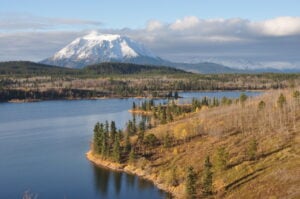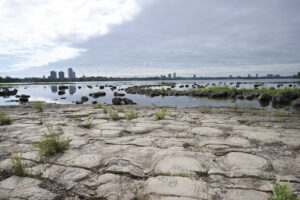They create a sort of frustration and dissatisfaction with the product that forces the end user to think, “Well, what are my options?” The plan is that the labels would have a prompt, like a website the consumer could visit to learn about other options and hopefully resolve that dissonance.
Can Geo: Some of the sample labels you’ve created highlight climate change impacts like species loss and ocean acidification, which are so big and far-ranging that they might feel beyond the scope of individual action. How effective will these labels be at connecting with the consumer?
Rob: Those examples are just thought-starters. Every municipality has a report or a document that says, ‘here are the health and environmental impacts we can reasonably expect from climate change.’ So when I speak to municipalities, I say go to that report and identify something that’s locally relevant. For Toronto, that might be increased incidences of flash flooding, so you could include an image from a couple of summers ago of the GO Train half-submerged in floodwater or cars stranded on the Don Valley Parkway. For a city in British Columbia, maybe the issue is the disruption of the shellfish industry as a result of ocean acidification.
Can Geo: Tobacco products have carried pictorial warning labels in Canada since 2001, yet people still smoke. Are you worried people may become desensitized to climate change warnings?
Rob: I don’t think so. I’ve explored some communications theory and psychology, and I think this is more effective than quantitative approaches like a carbon tax. In countries all over the world where you saw the implementation of the tobacco warnings, you did see a dip in consumption. If you label something as harmful, it contributes to a cultural shift. I’m also interested in how this can accelerate solutions from business and government.
Can Geo: By law, can municipalities actually compel private businesses to display something that is ostensibly discouraging people from purchasing their product?
Rob: That’s the conclusion that I’ve come to. When I looked at the case law, I saw some interesting parallels. For example, the City of Toronto used their general health and welfare powers to tell restaurants they needed to post their health inspection results in the window of their establishment. The Ontario Restaurant Hotel & Motel Association (OHRMA) took the city to court and lost. Ultimately, the health notice just provides information; the consumer can do what they want. The court hasn’t heard this particular argument yet, so it’s just my legal opinion, but I believe cities do have the power to require a retailer of a product in their jurisdiction to disclose the risks associated with the use of that product.
Can Geo: Where do you see this campaign heading next?
Rob: Ultimately, my strategy of going through the municipalities is informed by the fact that the federal government and the provinces often don’t lead. It just takes one leader to show the way, then some early adopters get on board, and eventually it makes for an easier conversation at other levels of government.
*Interview has been edited for length and clarity.






